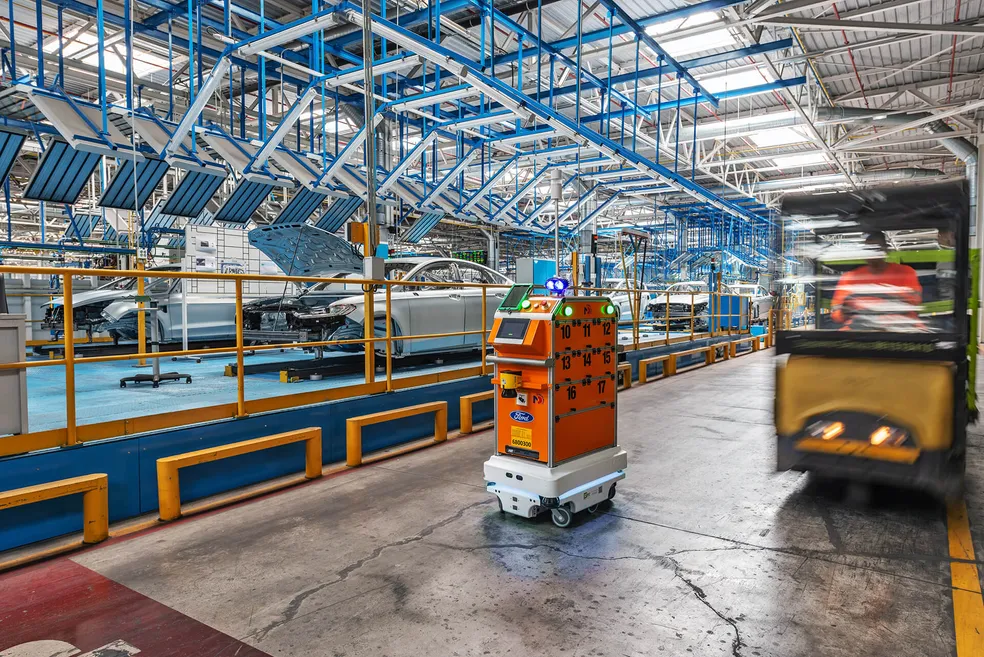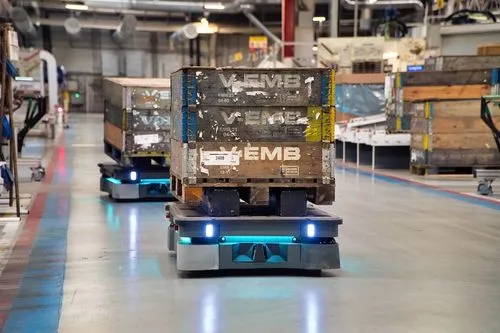In the fast-paced world of the automotive industry, efficiency and adaptability are paramount. Autonomous mobile robots (AMRs) are revolutionizing automation in the automotive industry. With their flexibility, precision, and ability to work safely alongside humans, AMRs are becoming an indispensable asset.
From assembly lines to material handling, AMRs streamline operations, reduce costs, and increase productivity. Whether it’s welding, assembly, or transporting parts, autonomous mobile robots in car manufacturing are equipped to handle a wide range of tasks. Discover how embracing this cutting-edge technology can propel your automotive business to new heights in our free e-book Intralogistics Automation in the Automotive Industry.

Why use Autonomous Mobile Robots?
At a time when global sales are down, the worldwide shift to electric vehicles, and the future of tariffs and personal vehicle ownership is uncertain, it’s tough to be in the automotive industry.
However, innovation is the key to success. While the industry is one of the most mature when it comes to adopting technology to stay lean, effective, and competitive, there is still vast scope to optimize.
How MiR mobile robots can help you
This is where automotive robots, particularly autonomous mobile robots, come into play. By integrating autonomous robotics in automotive manufacturing, companies can address many of the challenges they face. MiR robots are designed to:
Repetitive tasks: Freeing up the human workforce for more complex tasks. This not only improves productivity but also significantly reduces operational costs.
Agile and adaptable: The agility and adaptability of our AMRs make them ideal for meeting the dynamic demands of the automotive industry.
Learn all the benefits of how MiR robots can transform the way the automotive industry operates.
What are the benefits of automation in the automotive industry?
Increased Efficiency
AMRs take on repetitive tasks, reducing the risk of injuries and freeing up staff for value-adding tasks.
Flexibility
Customizable top modules can be added according to specific needs, further enhancing flexibility.
Cost-Effective
The easy integration of the AMRs minimizes downtime and allows for versatile applications
ROI
The ease of integration means that companies reap the productivity benefits of AMRs fast.
Automation in the automotive industry is a game-changer. By integrating autonomous mobile robots (AMRs) into their operations, automotive companies can reap many benefits. The most significant advantages include increased efficiency, flexibility, and cost savings.
Additionally, AMRs enhance safety, quality, space optimization, material handling, data collection, employee focus on higher-value tasks, and competitive advantage.
Let's delve into the key benefits:
Increased Efficiency
The automotive industry faces challenges such as high employment levels and increasing wages. With tightening margins and the need for a safe working environment, it's essential to optimize labor costs.
Robotics in automotive manufacturing address this by integrating AMRs into the workforce. AMRs take on repetitive tasks, reducing the risk of injuries and freeing up staff for complex, value-adding tasks in a safer environment.
This significantly increases efficiency, a critical aspect of automation in the industry.
ROI
There is unavoidable pressure on automotive industry to get leaner. Business leaders must be careful and cost effective. And in regions where labor costs increase as robotics price decreases there are clear labor cost optimization.
Not only this, but the ease of integration of AMR means minimal downtime with the ability to scope out further roles for the technology as it integrates with operations.
Add to this safety, optimized productivity and a more rapid response to market and industry pressures, the need to scope a ROI for AMR becomes more pressing.
Cost-Effective
The automotive industry is under pressure to become leaner. With fluctuating labor costs and decreasing robotics prices, automotive industry robots offer clear labor cost optimization.
The easy integration of the AMRs minimizes downtime and allows for versatile applications. Coupled with safety, enhanced productivity, and rapid response to market demands, the return on investment for AMRs is compelling and essential for business leaders.
Flexibility
The automotive industry, particularly parts suppliers, is facing escalating pressures. Fulfilling orders is becoming increasingly challenging, necessitating optimization of flexibility while minimizing downtime.
As demands surge, traditional technologies like forklifts and AGVs fall short due to the extensive time and cost required to alter production layouts.
Agile AMRs, equipped with sensors to evade obstacles, offer a solution. These collaborative robots in automotive manufacturing can be swiftly set up with no prior technical knowledge and minimal downtime. Additionally, customizable top modules can be added according to specific needs, further enhancing flexibility.
Which robots are used in the automotive industry?
Robots have been prevalent in the automotive industry for almost 60 years now, but the use of autonomous mobile robots (AMRs) is still relatively new. The evolution of robotics has brought forth a variety of robots used in the automotive industry. Among these, AMRs stand out for their intelligence and versatility. Unlike automated guided robots (AGVs), autonomous mobile robots can move out of the way of obstacles independently, are easy to set up, and don't require fixed routes. This makes them safer, smarter, and more flexible than AGVs.
Understanding the differences between AGVs and AMRs is crucial for making informed decisions in automation. Learn more about the distinctions between AMRs and AGVs.

